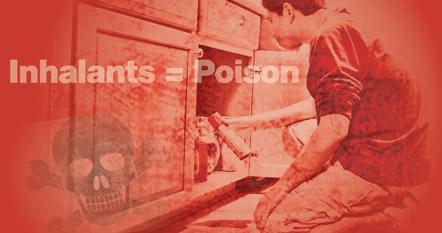
Inhalants = Poison: That’s the Message
Teens like to experiment. It’s just a part of growing up. But experimenting with inhalants can lead to permanent health problems or death—even after one session of “huffing.”
At a recent press conference to mark the 17th annual National Inhalants and Poisons Awareness Week, SAMHSA joined with other Federal agencies and the National Inhalant Prevention Coalition (NIPC) to raise awareness about the dangers of inhalants. Two people affected by inhalant abuse also shared their personal stories (see box).
New data from SAMHSA’s National Survey on Drug Use and Health (NSDUH) show that in 2007, 17.2 percent of adolescents age 12 to 17 who started using illicit drugs in the past year indicated that inhalants were the first drug that they used.
The report, Trends in Adolescent Inhalant Use: 2002 to 2007, also shows that the percentage of teens who used inhalants in the past year was lower in 2007 (3.9 percent) than in 2003, 2004, and 2005 (4.5, 4.6, and 4.5 percent, respectively).
Still, in 2007, almost 1 million teens used inhalants in the past year, with 0.4 percent of teens (about 99,000) meeting the criteria for inhalant dependence or abuse.
What’s the best way to educate children on the dangers of inhalant abuse? NIPC materials emphasize that when discussing inhalants with teens it is important to call inhalants “poison,” not drugs. Teachers and parents should focus on positive health messages, such as keeping the body supplied with oxygen and free from toxins.
Household products. Parents also need to educate themselves about the household products that kids use to get high. For instance, while SAMHSA data show that use of nitrous oxide or “whippits” was lower among past-year inhalant initiates in 2007 than in 2002 (16.3 versus 31.6 percent), use of aerosol spray other than spray paints was higher in 2007 than in 2002 (25.0 versus 12.6 percent).
Serious consequences. According to NIPC, some of the effects of inhalant abuse include loss of consciousness and sudden sniffing death syndrome, which can occur after the 1st, 10th, or 100th time an inhalant is used. Other effects include damage to the heart, kidney, brain, liver, bone marrow, and other organs. Read more on inhalant abuse in SAMHSA News online, March/April 2008.
Read Trends in Adolescent Inhalant Use: 2002 to 2007.
At the press conference for National Inhalants and Poisons Awareness Week, Allison Fogarty talked about her addiction to inhalants.
“What started as an escape from a bad day turned out to become a daily habit, which I was unable to stop by using just willpower,” she said. Ms. Fogarty has been in recovery from inhalant abuse since May 2008.
Although she did not suffer physical withdrawal, she said that resisting inhalants is still a daily struggle that she hopes will get easier with time.
“I am here on behalf of my 19-year-old daughter Erica Rain and all those who have lost family members from a dangerous toxic chemical—refrigerant,” said Dana Prothro to press conference attendees. “Erica made a mistake, a mistake that took her life within minutes.”
After losing her daughter, Ms. Prothro joined United Parents to Restrict Open Access to Refrigerant (UPROAR). The group works to raise awareness and alter building codes so that young people cannot access and sniff refrigerants from air conditioners. That’s what Erica did.
Find more information on UPROAR. To learn more about inhalant abuse, visit NIPC.